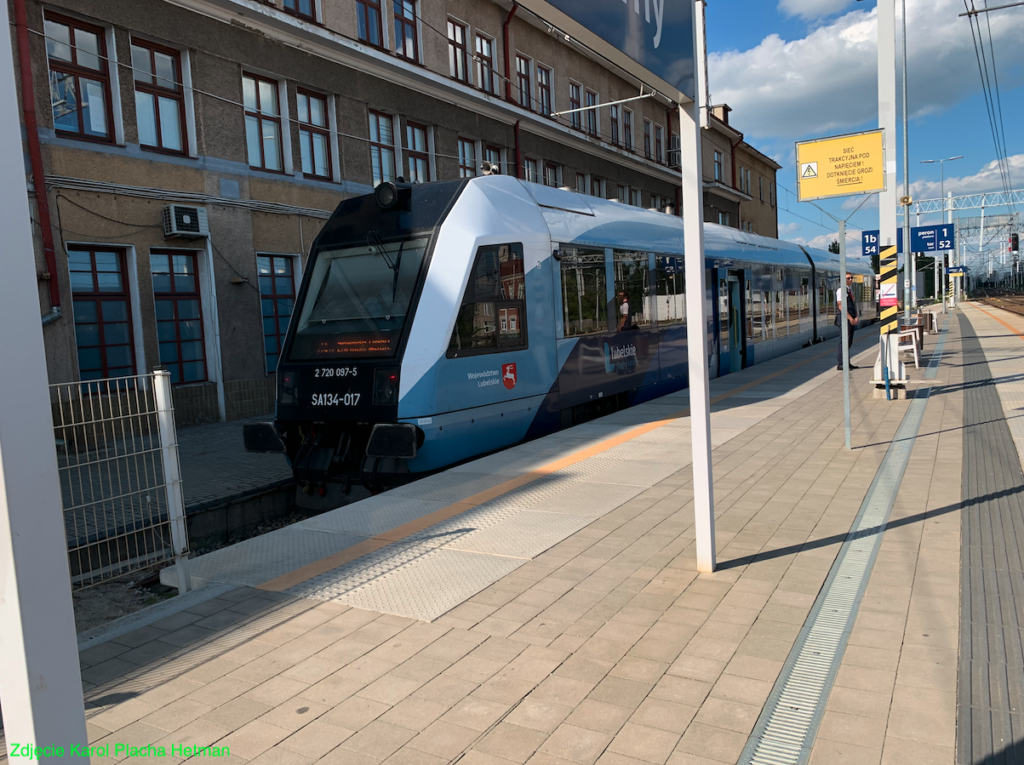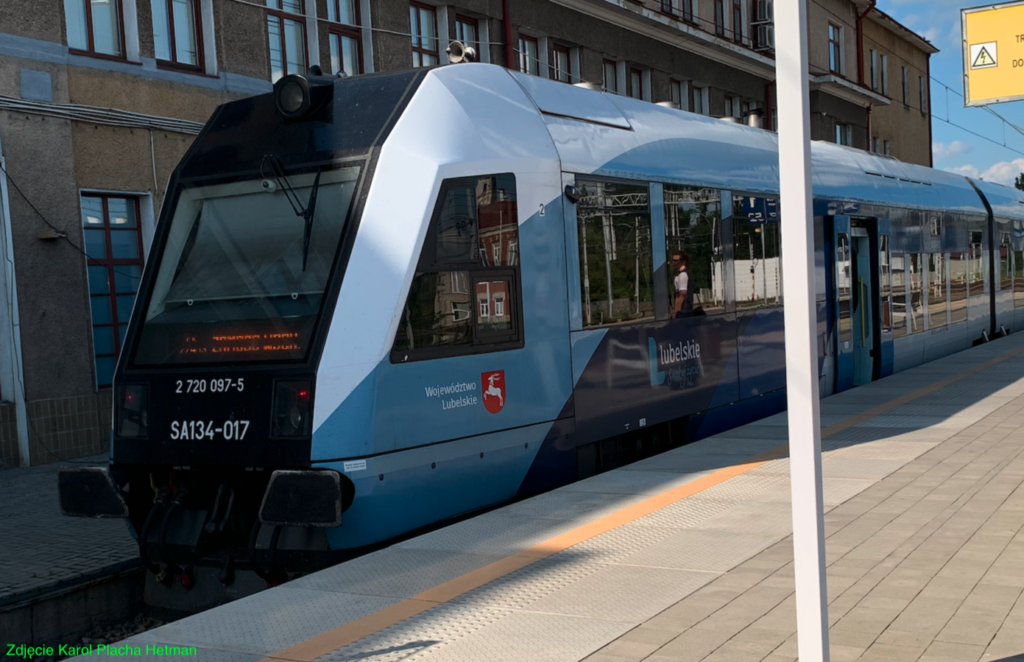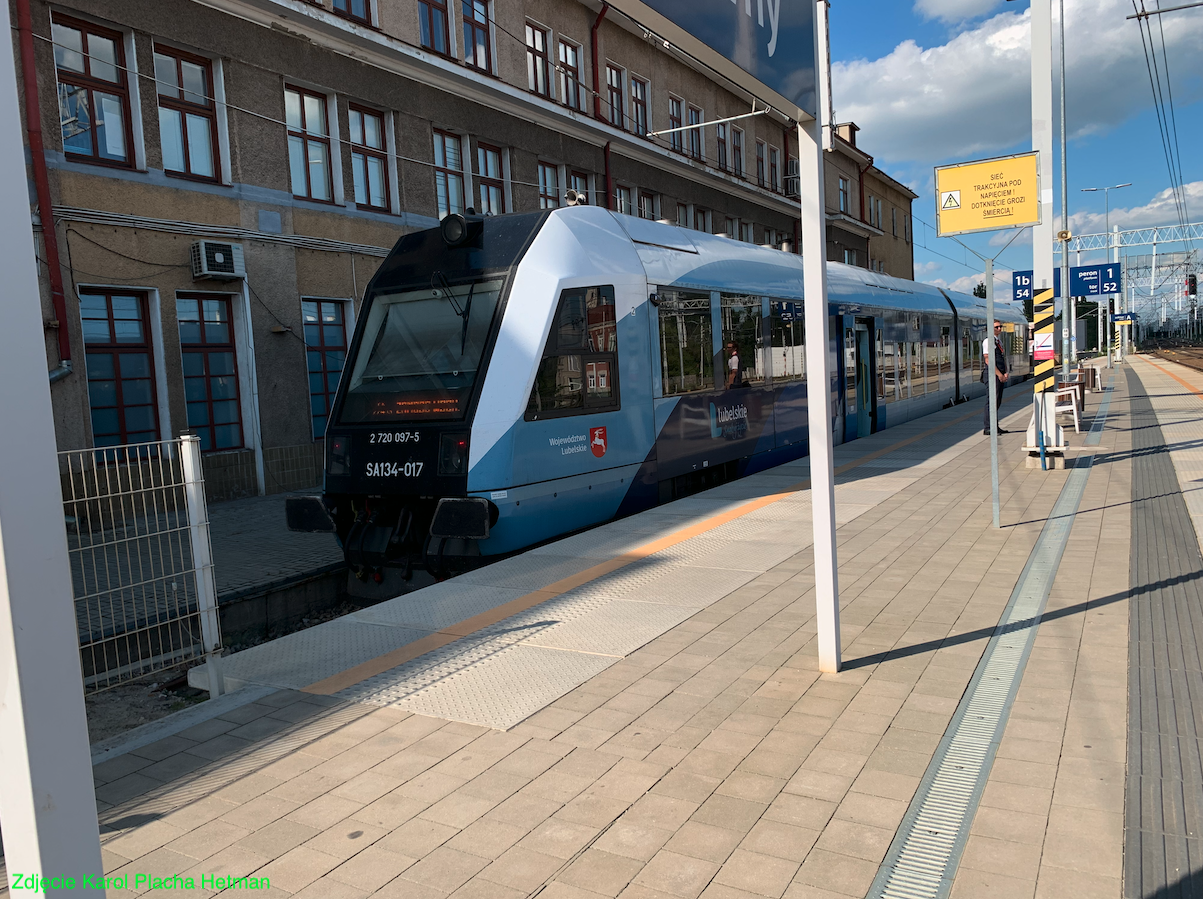Lublin 27-06-2024
SA134 Pesa 218M Diesel Multiple Unit.
The Pesa 218M is a two-car, normal-gauge SZT (Diesel Multiple Unit). These trains were produced between 2005 and 2015, by the Pesa Works in Bydgoszcz. The Pesa 218M trains comprise a family that received the type designations SA131, SA132, SA133 and SA134.


Genesis of the Pesa 218M train.
In 2000, there was another drastic liquidation of passenger rail services in Poland. The liquidation mainly affected local connections on non-electrified lines. It is true that these connections were served by large diesel locomotives and carried a small number of passengers. As early as 2001, the Pesa plant set about developing smaller passenger railcars. The first to be developed was the Pesa 214M motor car.
The construction of a two-car set was quickly started. The second carriage was to be a trailing car without or with a motor. The original plan was to combine two Pesa 214M motor cars. The project proposed eliminating one of the driver’s cabs and installing an inter-carriage gangway for passengers and staff in that place. Such a train was to be 49 m long. Each carriage was to have two bogies; one driving and one rolling. This new two-car train was to be designated Pesa 217M.
But in the end, in 2005, Pesa decided on a slightly different design. The coaches were connected by a single Jacobs-type rolling bogie. The first Pesa 218Mx train of the SA131-001 type was built and ordered by the authorities of the Pomeranian Voivodeship. The Pesa 218Mx train was a development of the Pesa 219M Atribo model, a 3-car train. This version of the train was produced from 2007 onwards.
In the following years, the next generation of 2-car SZTs was developed at the Bydgoszcz plant, designated 223M Link, with the front end characteristic of the new locomotives and EZTs from Bydgoszcz.
SA131 – SA134 series.
The PESA 218M family comprises the SA131, SA132, SA133 and SA134 series.
When the new trains were to be given a type series designation, a small problem arose. The train was classified as a “rail bus”, i.e. it was assigned the designation SA. But the designation system for diesel railcars (SA101 – SA110), in force since 1970, had already been exhausted. It was decided to add further designations from SA131 upwards. Only one Pesa 218M train of the SA131 type was built. Pesa 218Ma and 218Mb trains were designated SA132. Further modernised trains were designated SA133 and SA134.
The first trains were ordered by operators in December 2004. One train each was ordered by the UM of Pomorskie Voivodeship, Wielkopolskie Voivodeship and Dolnośląskie Voivodeship. From 2006, further provinces ordered 2-3 trains each.
Pesa 218M train design.
The Pesa 218M SZT is a 2-car train. The train in the interior is single-space. There are no inter-carriage doors. The train has a weight of 76,000 kg – 82,000 kg.
The train has three bogies. The outermost bogies are two-axle drive bogies moved by a diesel engine. A PowerPack engine with hydraulic transmission is used for propulsion. The engines used are: MAN D2876LUE623, with 382 kW, Voith R2876T3-390, with 390 kW, MTU 6H1800R81, with 350 – 360 kW. A drive shaft comes out of the engine, which runs to the gearbox of the first axle. From this gearbox, another shaft comes out, which connects to the gearbox of the second drive axle. This type of drive can be applied to 3-car SZTs. The train has two diesel tanks with a capacity of 580 litres each or 650 or 750 litres.
The suspension of the train has two stages of suspension. The first is metal-rubber elements, while the second is pneumatic springs with which the body is attached to the bogies. Most of the train’s equipment and accessories are located under the carriages’ bodies: batteries, fuel tanks (diesel), air tanks, compressors, “PowerPack”.
The wagon bodies of the different types differ in detail. The bodies are made of a spatial steel truss made of hollow sections. The shells are made of aluminium alloy sheets, which are assembled by gluing. The front walls are made of plastic. The windows are glued in. Automatic doors of the bounce-slide type were used. The number of doors depended on the customer. Normally each wagon has one pair of doors per side. The width of the wagon entrance is 1.30 m. The height of the entrance is 0.60 m from the rail head. The doors can be opened with a button by the passengers or by the driver. The closing of the doors is carried out by the driver.
There are small screens at the doors, approximately 0.50 – 0.60 m wide. There is usually one closed type toilet on the train, suitable for wheelchair users. Passengers have passenger information displayed on LCD monitors. There is CCTV on the train.
Train heating is provided by heat from the diesel engine cooling system in the form of a Webasto Thermo 350 heating unit. Electric vents are additionally installed at the entrance doors. Air conditioning is used to cool and ventilate the train. The air-conditioning parameters depended on the customer. The air conditioners are mounted on the roof of the coach body.
The floor in the train is about 50 % low (0.60 m from the rail head) and about 50 % high floor and stairs (bogie region). The type of passenger seats, their layout and the colour of the upholstery; depended on the purchaser. The train has a maximum of 175 seats. Normally there are 134-146 seats on the train.
The manufacturer of the trains is PESA Bydgoszcz in cooperation with ZNTK Mińsk Mazowiecki, which has become a subsidiary of PESA.
Lubelskie voivodship.
On 3 December 2009, representatives of the Marshall’s Office in Lublin signed a contract for the delivery of 5 SZT trains by the consortium of Zakładów Naprawcze Taboru Kolejowego “Mińsk Mazowiecki” and PESA. The vehicles were ordered to serve three routes, from Lublin to: Stalowa Wola, Lubartów and Lublin Airport. On 24 June 2010, the first of five 218Md Minsk 2 trains was handed over to the Lublin Regional Railway Company. The last, fifth vehicle was delivered to Lublin on the night of 14-15 December 2010.
In service, the trains were also diverted to the Lublin-Rzeszow route. The route was operated jointly with trains from the Podkarpacie region of the SA135 series. However, in December 2012, this connection was discontinued.
On 9 October 2012, Lubelskie Province ordered a further three trains, with delivery by September 2013.
On 26 February 2013, the Lublin-bound SA134-019 train between Zamość and Rejowiec collided with a passenger car, resulting in the vehicle being partially burnt out. In mid-2013, the train was transported to the manufacturer to be rebuilt.
On 2 April 2013, with the launch of passenger services on the Lublin-Lubartów line, the SA134-026 train was ceremonially presented to the Lublin Voivodeship. Two more vehicles were later delivered, numbered SA134-027 and SA134-028.
T-T SA134 data:
Axle arrangement: B’2’B’. Length 41.70 m. Width 2.89 m. Height 4.13 m. The train has a weight of 82,000 kg. Operating speed 120 km/h. Design speed 140 km/h. Wheel diameter 0.84 m. Voith R2876T3-390 internal combustion engine, rated at 2 x 390 kW. Voith T211re.4 hydraulic transmission. SAB-Wabco brake system + retarder.
The retarder or retarder is the so-called mountain brake. It is a device used for prolonged braking of the vehicle. In practice, it is used to prevent excessive speed increases, for example during long downhill runs.
Written by Karol Placha Hetman
